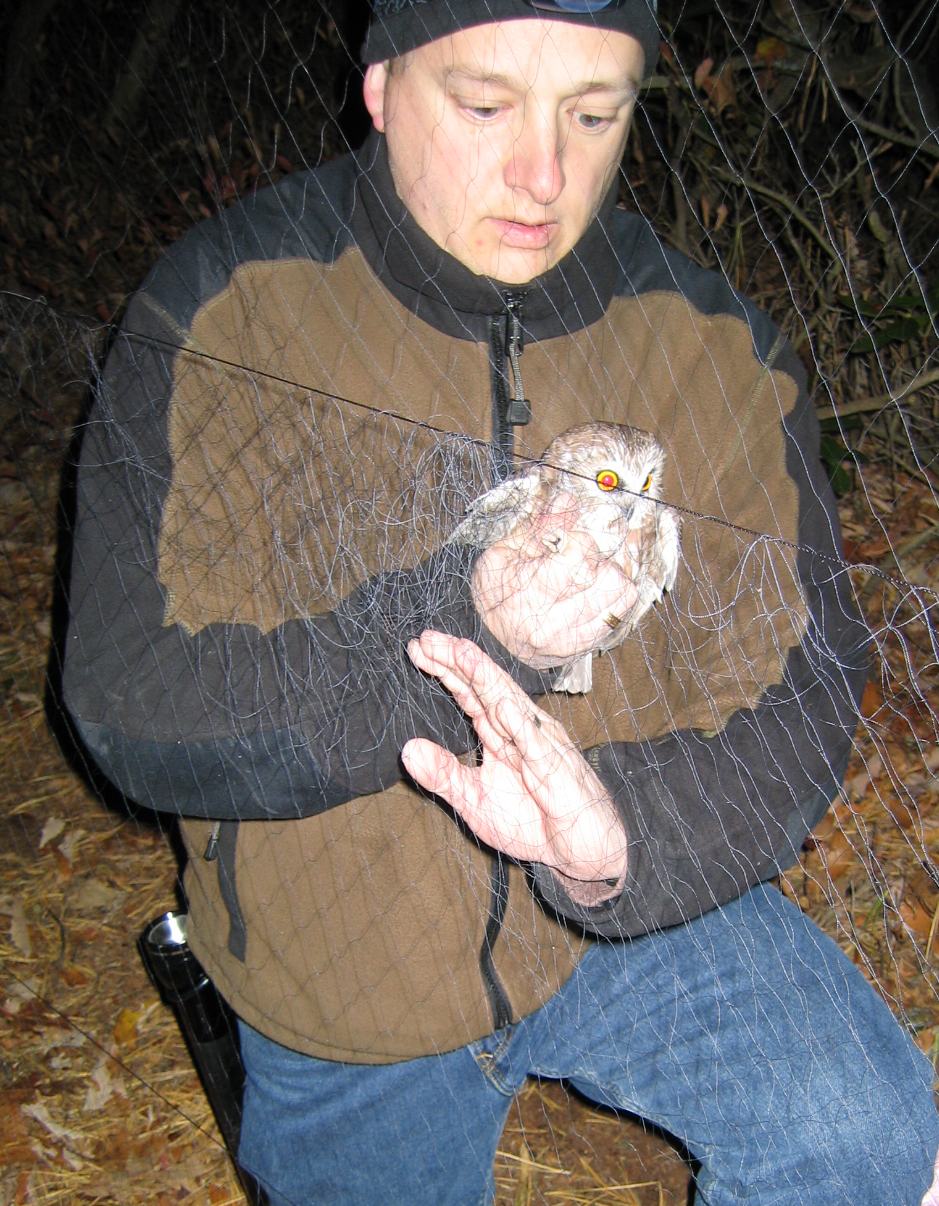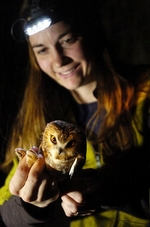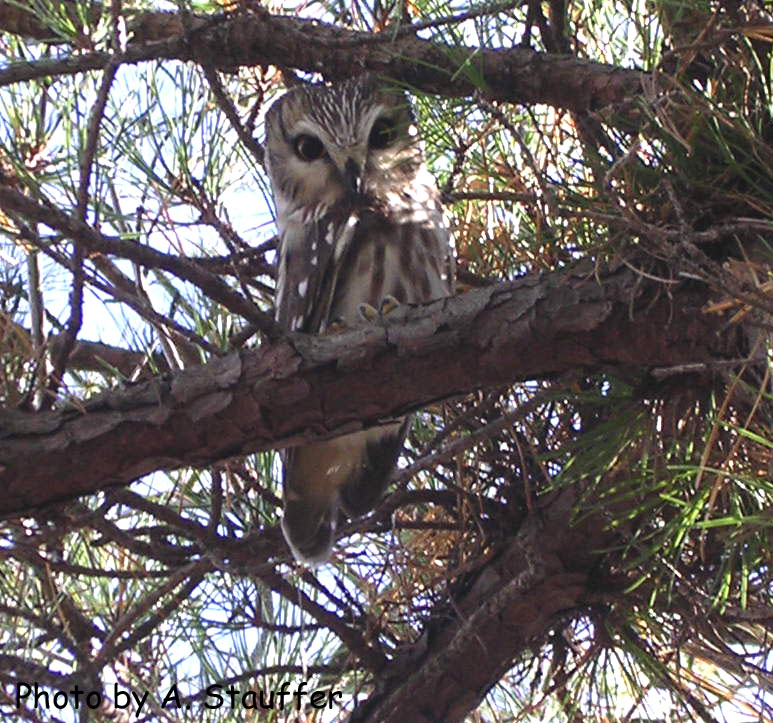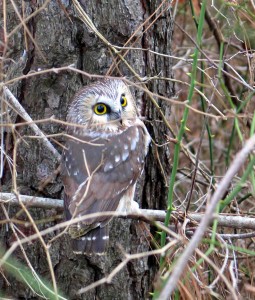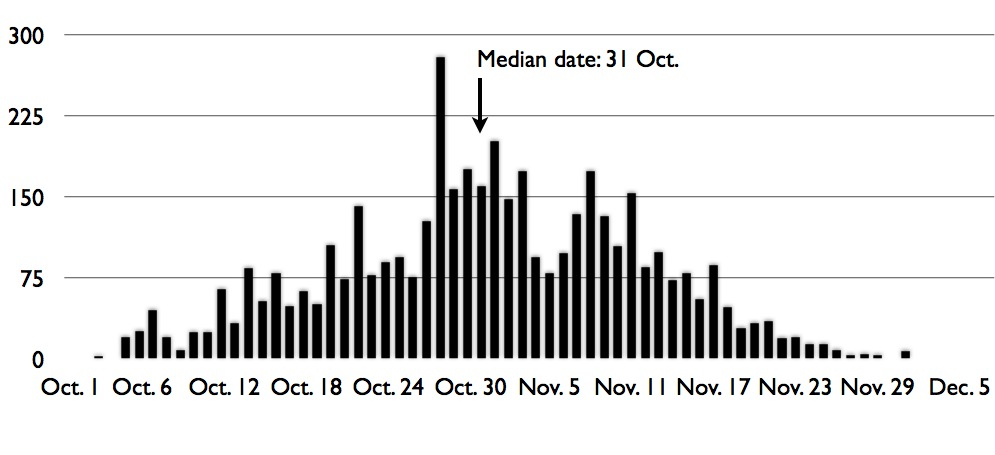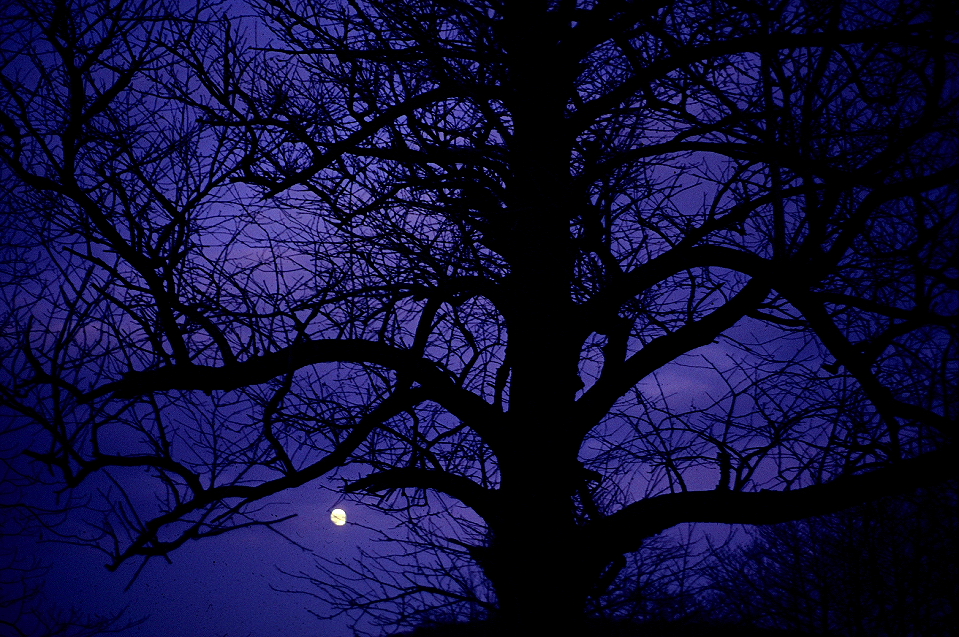Note: The capture and banding of any wild bird, including owls, is strictly governed by federal, state and provincial laws, and is illegal without necessary permits. For information on bird banding regulations in the United States, contact the federal Bird Banding Lab ; in Canada, contact the Canadian Wildlife Service .
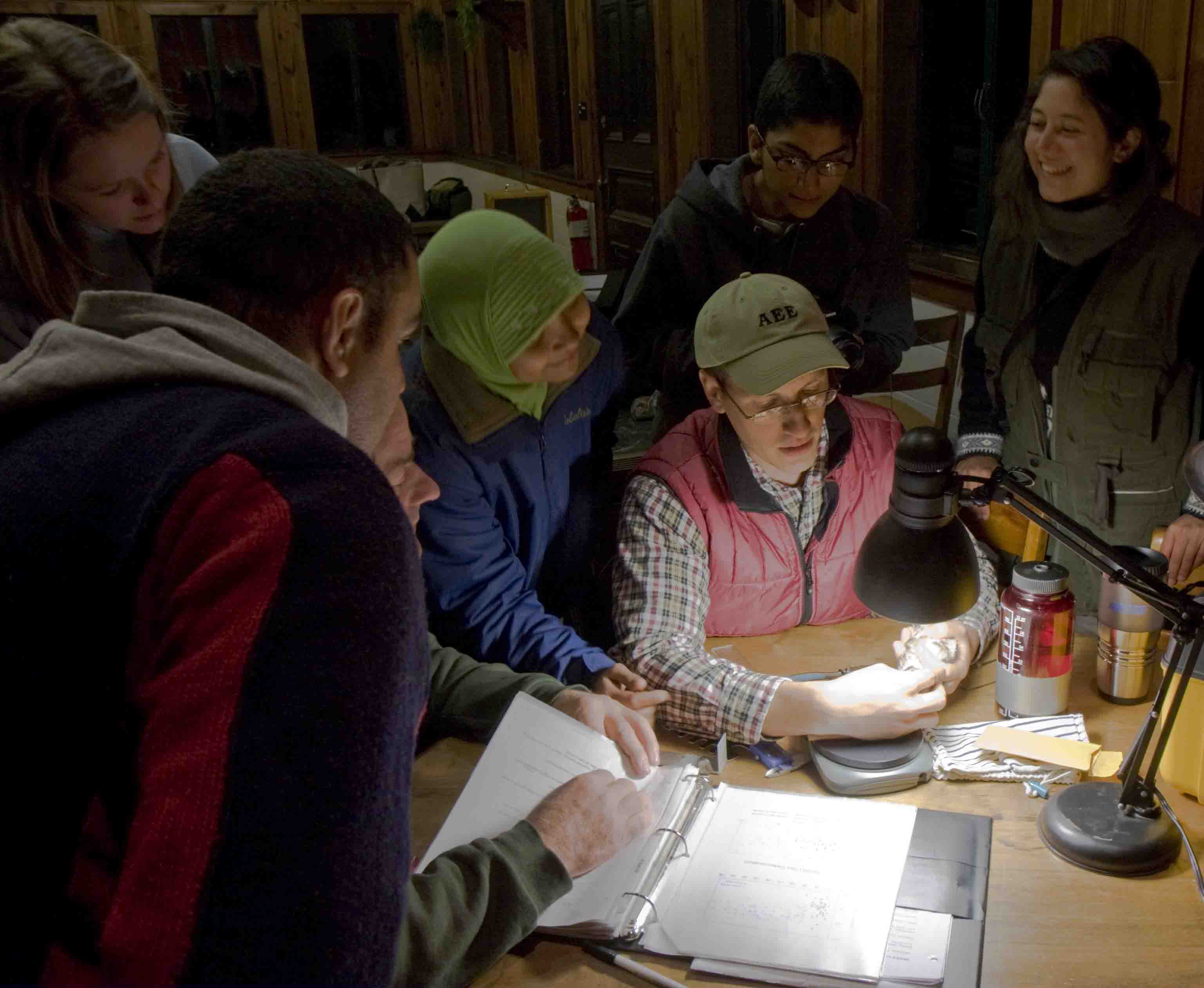
©Scott Weidensaul
Capturing migrant owls largely depends on the use of mist nets and a mechanical audiolure with which to attract them. Details of net arrays and layouts vary significantly among stations, depending on terrain, habitat and the species being targeted. What is offered here is a basic plan that has proven itself over time.
The importance of standardization: Simply banding migrant owls and reporting recaptures is obviously beneficial, but to maximize the value of a netting operation, we strongly urge banders to settle on a standardized layout and operation, and maintain records of effort so that their results can be normalized and compared with other sites. For a thorough explanation of the importance of standardization in monitoring migrant owl population trends, see Dunn 1999.
Banders should record the following measures of effort: hours of audiolure time, area of nets, and a calculation of captures per effort (ideally, owls per 102m per 100 hours of audiolure time). Use of a net area measure (102m) rather than simple net-hours allows for comparison between sites with single-tier nets and double-tier arrays.
Net size: Most owl banding is conducted with several 12m mist nets, with the mesh size varying with the targeted species. For small owls like northern saw-whet, boreal, flammulated and screech-owls, 60mm nets (“thrush nets”) in 120 denier are recommended. For medium owls (long-eared and barn), 121mm nets (“duck nets”) in 220 denier are preferable. Passerine nets (30 and 36mm) can be used in a pinch, especially if the trammel lines are pushed together to create deep pockets, but even small owls can climb out, and your capture rate will suffer.
Net arrays: Banders have tried a bewildering range of net layouts, from simple lines to triangles, squares, crosses and zigzags. Some stations even deploy double-high (tiered) nets. Most stations, however, use a simple line of at least three or four 12m nets, with the audiolure placed at the center of the line. We recommend a minimum of four 12m nets. (Bear in mind that in autumn hardwood forests, more nets mean more fallen leaves to remove on windy nights – not an insignificant consideration, when a single net may snag hundreds of leaves on a bad night.)
There is evidence that smaller saw-whet owls (presumably male) and recaptures are more likely to be caught farther away from the audiolure, suggesting that a short line or closed array like a triangle will miss some owls (Whalen and Watts, 1999). Partly for that reason, and also on the assumption that some owls will simply circle the array and evade capture, we do not recommend the use of triangles or squares.
Siting banding stations, and placing nets: In many cases, owls captured at night will be lured from active migration, and so netting can be successful in what would otherwise be considered inappropriate habitat. But while is not essential to chose “typical” owl habitat, there are several aspects of siting that will increase success. What follows pertains largely to saw-whet owl stations.
Because the audiolure is most effective at high volume, a relatively remote location (or one with deaf or sympathetic neighbors) is a good starting point. Most banding sites are located in large areas of forest, often on or along ridgelines, or on coastal locations (ocean or Great Lakes) but again, this is not essential.
The nets, however, should be placed in thick understory cover whenever possible. Small owls feel more secure from attack in thick cover, and as with diurnal passerine netting, the understory will serve to break up the out line of the nets. An ideal setting would be fairly narrow net lanes cut through dense evergreen cover (conifers, laurels, etc.). Avoid netting in fields, bogs and other open locations.
Net lane orientation (N-S, E-W, etc.) seems to make no difference. Observations of responding owls shows that saw-whets often fly back and forth in the surrounding vegetation for quite a while before being netted, so there is no need to place the net line perpendicular to the presumed direction of travel.
Audiolure: The use of an audiolure is essential to capturing a reasonable number of migrant owls. To be effective, the sound system used should produce 90-110 dB; within reason, the louder the lure, the larger the area being sampled, and the higher the capture rate. A single audiolure is usually placed near the middle of the net array with two speakers aimed in opposite directions. The speakers can be placed on the ground, or on posts 1-2m high.
Audiolures can take a variety of forms. The most basic is a large CD player (“boom box”), which can work for exploratory efforts, but has several drawbacks. Few boom boxes produce the required volume, and unless there is a nearby electrical source, they consume too many batteries (think green) operating through the night in frequently cold conditions. Digital or tape-player predator calls are an improvement, but again, few produce the required volume. One that has received good reviews from users, however, is the Fox Pro NX3.
Most permanent banding sites use a digital sound system designed specifically as an audiolure, with a rechargeable 12v/7.5w battery, MP3 player, amplifier and bullhorn speakers. Such a unit can be assembled by someone with basic electrical experience using off-the-shelf parts for about $150 U.S. A parts list and detailed assembly instructions are here.
Audio files: Downloadable audio files of several species of owls, for use in audiolures, are found here.
Net checks: Many (perhaps most) saw-whet owl banders make hourly net checks, striking what they believe is a balance between the welfare of the bird, and too-frequent disturbance at the nets. Northern forest owls like saw-whets and boreals seem to be extremely hardy in cold conditions, and except in unusually harsh weather may be safely netted for longer periods than would be considered safe for passerines, but exposure is only part of the equation; less frequent net-check increase the risk of predation, for example. It is important to be flexible, responding to changing conditions; hourly checks may be acceptable at 20°F/-6°C in calm conditions, but not with a 20 mph/32 kph wind, or if a predator is known or suspected to be in the vicinity.
The number of owls captured per night varies dramatically with location and date. Some major migration points (generally in the Great Lakes region) may experience 75-100 saw-whet owls/night at peak season. This may overwhelm a single operator. A bander faced with an unexpectedly large flight or poor weather can shut off the lure, effectively stopping any further captures, and close nets as they are cleared until it is safe and responsible to continue netting.
Remember, the welfare of the birds is a researcher’s first priority.
Migration phenology: As a general rule in Canada and the northern half of the U.S., significant numbers of northern saw-whet owls arrive in autumn as deciduous foliage nears peak color, and the flight diminishes greatly three or four weeks after leaf-fall. Thus, migration begins during mid-September north of 45°N, late September to early October north of 40°N, and mid- to late October south of 40°N. South of 36°N migration probably begins during early November, although migration phenology in the South remains unclear, and captures of saw-whets in northern Alabama as early as mid-October suggest some owls arrive far earlier than once assumed.
Spring migration has been poorly studied. Sites in the mid-Atlantic region that have conducted spring netting have experienced dramatically lower capture rates than in fall; whether this is due to high over-winter mortality or other factors is unclear. In Pennsylvania, peak spring captures have varied from the end of February through mid-March, and there is speculation that snow cover may effect the timing of northbound migration on a year-to-year basis. Wintering birds monitored by telemetry in coastal Maryland and southcentral Pennsylvania departed by early to mid-April.
Moon phase appears to have some effect on capture rates, with bright nights yielding fewer owls. It is unclear, however, whether this is a function of the owls detecting the nets, or if this reflects an actual reduction in migration. Most productive time of night appears to depend on location and circumstance, and more study is needed. At Cape May, NJ, most saw-whet owls were captured in the four hours preceding dawn, with 60-70% of captures occurring after midnight. But at Assateague Island, MD, when three years of effort were summarized by three-hour blocks, 60-70% of captures occur before midnight. At three sites in central Pennsylvania, owl captures peaked four hours after sunset, and dropped off dramatically after midnight. Some banding sites net all night, some for part of the night; some every night, others less frequently. Whatever your approach, and to the extent possible, we urge all operators to standardize their protocol from year to year (per Dunn 1999) to maximize the value of such data for long-term monitoring.
Weather: Ideal conditions in autumn typically follow the passage of a cold front, especially blustery northerly winds that fall calm at sunset. Cold, calm, dark-moon nights are generally best. In spring, a southerly air flow and a warm front seem to produce good flights. High winds, precipitation and fog are rarely good.
Age/sex class differences. Summarizing six years of data from Pennsylvania, immature (fall HY) owls were found to migrate significantly earlier than adults, which had significantly higher mass and averaged longer periods of stopover than HYs. Most stations report a significant female bias; at three sites in Pennsylvania, saw-whets categorized as male using a mass/wing chord discriminant analysis accounted for only 6 percent of fall captures, while females were 77 percent; the remaining 17 percent could not be assigned to gender. The use of a male advertisement call as an audiolure does not wholly explain this disparity (Duffy and Matheny 1997).

